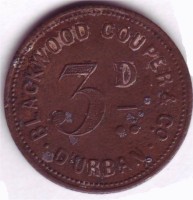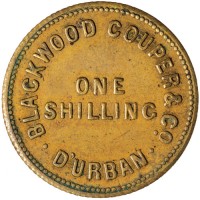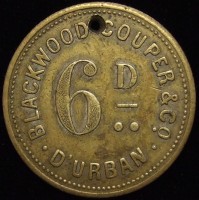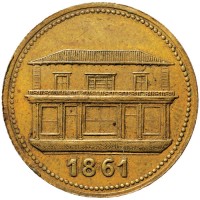



Common reverse of the building

The Blackwood Couper building can be seen on the right (click on thumbnail for exact location).
Pat Moran, in his book "The tokens of Natal" discusses the tokens in detail.
The store had three tokens, a 3d (in copper) and 6d and 1/- (in brass) issued in 1861. The coins were created because of the shortage of coins from the Crown circulating in what was then a remote region of the British Empire.
The company was a General Merchant and Shipping Agent.
It traded from West St in Durban from 1834 but was burnt down on 1st May 1864. (See article below).
All three coins are extremely rare. The Balson Holdings Family Trust owns a complete set (displayed below).
The Natal Mercury, the local Durban newspaper reports as follows on 3rd May 1864:
We deeply regret to have to report the destruction by fire of one of the finest buildings in Durban. On Sunday at about five o'clock, a resident of the East End of West St, happening to look out, saw a glow of lights issuing from the centre window of Messrs Blackwood Couper and Co's new and large premises, erected as lately as 1861. The alarm was at once given, and Mr Blackwood and Mr J Couper, together with the police under Superintendent Bennett, speedily gathered around the place. There is only one fire engine in Durban, and that is the one at the military camp. This was at once sent for, and soon arrived at the scene of action under the charge of Sergeant Major Macknight, whose exertions throughout the melancholy proceedings were beyond all praise
By this time it was nearly six o'clock, and before the water could be got to play on the building the flames had been raging within, as was evident by the volume of smoke which began to issue from every aperture, as well as the glare of lights which soon burst through the windows of the upper floor.
The first well which to the hose was attached was unhappily proved almost dry, and some little difficulty was experienced in securing anything like a proper supply of water. About quarter past six the Mayor, Mr Gillespie appeared, having only just heard the alarm, and he immediately proceeded to organise the large force of white and coloured volunteers upon the ground, and energetically to obtain systematic action. Mr Hed, Mr Griffin, Mr Cato and other neighbours has arduously been endeavouring to rescue the property that was threatened with destruction inside.
A chain of kafirs numbering about 150 was finally formed to carry water in buckets from the large lake-like pools that have been formed by the late rains to the rear of Pine Terrace. European volunteers worked untiringly at the engine which was then fed, while the horse, under the direction of the Mayor, Mr Leathern and others, poured a steady stream of water upon those parts of the building where danger was most imminent. By this mans the back store was saved. The iron shutters in front prevented any egress for the flames, and the heat must have been intense, judging from the way the iron was curled up and twisted. The iron roof was not long in falling in, with a loud crash, and efforts were were then made, to prevent any risk to adjacent buildings by the falling outwards of the burning masses. So strong a hold had the fire got within, however, that all attempts to to save the bulk of the goods in the front of the store were obviously useless, although they were repeatedly made, Mr Leathern and Mr Head particularly distinguished themselves in this way. Fortunately the adjoining stores at the back principally stocked with the heavier goods, were saved without much material injury, and their contents removed to a place of safety. The office was also emptied of its important contents, and no loss of goods or documents had been suffered. But the grocery and soft goods departments in the ground floor and the extensive showrooms fitted with fancy goods upstairs were completely swept.
Although white men and kafirs worked with a will and zeal that were highly honourable, the flames did tehir worst of the main structure, bursting through the windows, consuming the floors, and seizing hold of every piece of woodwork in the building except what was in the office, so that completely gutted, the four walls - roofless - and iron portion were at last all that was left: the only vestige of what had been one of the handsomest eddifices of the town, and the special ornament of the east end. Special efforts were directed towards the office, the ceiling, floor and woodwork of which are comparatively little injured.
Most of the token coins were destroyed in the fire with the few remaining pieces believed to be in the hands of Durban residents at the time of the fire.
The following comment in describing a one shilling Blackwood Couper coin which sold on auction for about US$300 in September 2008 on Dix Noonan Web auction website supports this theory on why the coins are now so rare:
Footnote
Durban, Blackwood Couper & Co, brass Shilling, 1861 (Hern 64a; Theron N9; Ford 5479). Blackened from fire damage, otherwise fine, rare
Blackwood Couper & Co, grocers, West street; the company’s building shown on the reverse of their tokens was burnt down on 1 May 1864 and the majority of the tokens now extant show signs of fire damage. Interestingly the tokens bear the old name D’Urban, for which the city was renamed from Port Natal in honour of Sir Benjamin D’Urban in 1835




Common reverse of the building
3d ex W.J. Noble Collection, Sale 61B (lot 1607) and Spink Sale 96 (lot 372 part).
6d ex Allyn Jacobs Collection (2009)
1/- bought on Auction at Noble Numismatics - 23 July 2009; Lot 2401<